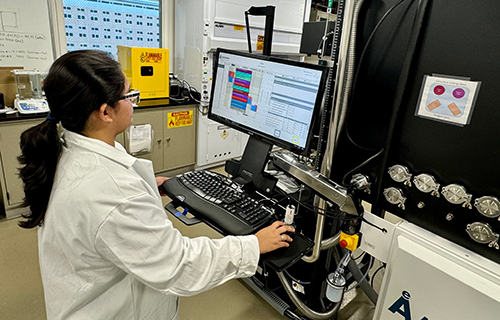Aesha Patel, a Ph.D. student in the Department of Physics and Astronomy at The University of Toledo, began a prestigious internship at the National Renewable Energy Laboratory (NREL) earlier this year. Her research focuses on advancing cadmium telluride (CdTe) solar cell technology, a key area in photovoltaics — converting sunlight into electrical power — with applications on Earth and in space.
“This internship has been an incredible opportunity,” Patel said. “NREL is the only federal lab focused on renewable energy, and being here allows me to contribute to groundbreaking research in solar energy. It aligns perfectly with my career goals and passion for creating sustainable energy solutions.”

Aesha Patel, a Ph.D. student in UToledo’s Department of Physics and Astronomy, began a prestigious internship at the National Renewable Energy Laboratory (NREL) earlier this year.
At NREL, Patel’s work addresses two critical challenges in CdTe solar cell technology: enhancing the back contact of CdTe solar cells to improve efficiency and developing CdTe cells for space applications.
The former project is a U.S. Department of Energy-funded collaboration between UToledo, Colorado State University, First Solar and NREL. Patel’s experimental research seeks to create what is known as passivated back contact, which optimizes both the current and voltage to achieve maximum efficiency. She constructs structures to test various passivation strategies and evaluate their effectiveness using photoluminescence and time-resolved photoluminescence techniques.
The latter project involves creating efficient CdTe solar cells on space-qualified cover glass, which is typically about 100 micrometers thick, comparable to the thickness of a human hair. New communication satellite technologies have increased demand for solar power in space, driving Patel’s work to create more efficient and cost-effective alternatives to traditional space PV options. This work presents considerable challenges in materials science and is driven by the increasing demand for solar power in space through evolving communication satellite technologies.
“NREL’s focus on clean energy aligns perfectly with my desire to specialize in thin-film solar research,” Patel said. “The interdisciplinary environment and mentorship here have greatly enhanced my research skills and provided valuable insights into the field.”
Patel’s academic journey began with a bachelor’s in chemical engineering from L.D. College of Engineering in India, followed by a master’s in chemical engineering from Arizona State University. Drawn by the Wright Center for Photovoltaics Innovation and Commercialization’s (PVIC) renowned thin-film PV research, she is now pursuing her Ph.D. at The University of Toledo.
“The Wright Center’s aim to drive innovation and commercialization in the PV community is what drew me to UToledo,” Patel said. “I’m so glad I made this decision. It has positioned me for opportunities like this internship and for a fulfilling career.”

Aesha Patel’s research at the National Renewable Energy Laboratory focuses on advancing cadmium telluride (CdTe) solar cell technology, a key area in photovoltaics — converting sunlight into electrical power.
Patel began her ongoing research at UToledo’s PVIC under the guidance of Dr. Randy Ellingson, professor in the Department of Physics and Astronomy and PVIC Endowed Chair, and other faculty members, all of whom have been integral to her success.
“PVIC has a plethora of resources for thin-film research, and the collaborative culture — both internally and externally — has broadened my knowledge of solar research,” Patel said. “The research skills I developed while working at PVIC were crucial in making me eligible for this internship.”
“Aesha arrived at PVIC with a clear vision to use materials science to achieve maximum impact in the field of thin-film PV technology,” Ellingson said. “At UToledo, she quickly developed expertise in designing and characterizing all the layers of modern CdTe solar cells. Her willingness to mentor another student, in collaboration with Dr. Matthew Reese of NREL, ultimately led to her securing this year-long internship. Aesha is honing essential skills to advance CdTe PV technology for terrestrial and space applications.”
As Patel looks ahead, she is determined to continue her research in the CdTe thin-film community. “Research is where my heart lies,” she said. “The foundation I’ve built at UToledo’s PVIC and NREL will enable me to keep contributing to the field even after graduation.
“Growth happens in the uncomfortable spaces between challenges and resilience,” she added as advice to incoming freshmen. “Explore and find your passion, don’t be afraid to fail, reach out to professors and researchers to seek mentorship, foster meaningful connections with peers, stay curious and keep learning.”